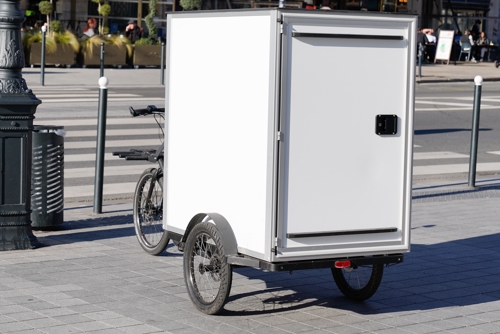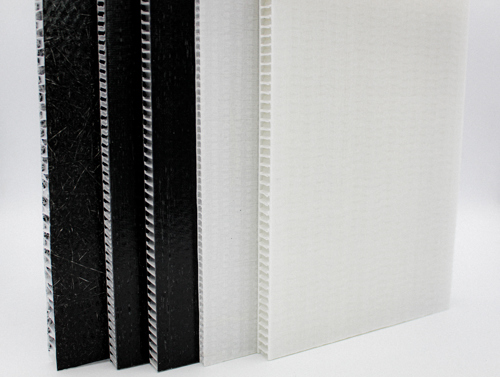With the challenges of climate change and the environment progressively becoming more pressing, manufacturers and engineering companies are looking for revolutionary materials that could be more sustainable, yet at least as effective, options across a range of industries. This particularly applies to reinforced plastics panels, which are used across a range of industries from trains, trucks, buses and automobiles, to construction and leisure.
There are many ‘sustainable’ materials on the market, each having its own benefits and suitability for particular applications. But their sustainability should be assessed by looking at their production through to their end of life, taking into account factors such as these:
- At the start of the process, can their raw materials be sourced from recycled materials?
- How energy efficient is their production process?
- How easily are the reinforced plastics products incorporated into their customers’ production lines?
- What is the eventual environmental benefit to the finished product?
- How easy is it to dispose of or recycle the material at its end of life?
An increasingly popular solution is sandwich panel technology, consisting of fiber-reinforced composite skins sandwiching a core, which delivers excellent mechanical performance combined with weight reduction, compared to monolithic panels. Among the various types of sandwich core, a honeycomb structure has proved to offer the highest performance-to-weight ratio compared with other core materials, such as foams, which is why it is the structure of choice in the aerospace industry.
It appears that with the right production technology, honeycombs – particularly those made of thermoplastic materials – can be competitive enough to address more down-to-earth and cost sensitive applications.

Construction and materials
Honeycomb structures are a lattice of hollow, thin-walled cells with exceptionally high out-of-plane compression and shear properties while boasting a low density.
The face sheet of a honeycomb sandwich usually consists of thin composite laminates that we make by using a cross-ply of UD tapes of glass fiber embedded within a polypropylene matrix. The honeycomb core is typically made of polypropylene thermoplastic resin, at least in large-volume and cost-sensitive applications. These panels have remarkable strength, yet are 60% lighter when compared to plywood core panels faced with 2mm GRP.
Thermoplastic honeycombs have another important advantage over plywood because they are resistant to pests: termites, carpenter ants, beetles and other pests can eat away at wood, causing extensive damage. But that is not their only benefit: manufacturers are replacing plywood with lightweight composites, due in part to cost; plywood has increased in price by over 25% in the past year.
With recent innovations, we have produced polypropylene honeycomb panels in a fully continuous, automated process. This creates a huge advantage in terms of production costs and product pricing. The panels combine the benefits of polypropylene-based composite material and the honeycomb structure to provide excellent flexural rigidity and impact strength at a very low weight.
They are typically used as flat panels but, thanks to the thermoplastic components, they can also be shaped into parts that have structural complexity.
Thanks to the huge difference in weight, honeycomb panels are much easier and cheaper to transport and handle compared to plywood. They also have better acoustic properties, as they can absorb sound in midrange frequencies and above. Plywood, on the other hand, reflects nearly all sound waves, making it ineffective in noise reduction in buildings, especially in industry.

Composites
Across a wide range of industries, project managers and engineers are finding that composites are an excellent replacement for traditional materials such as metals and wood.
This is predominantly due to weight but other factors, such as design freedom, formability and other properties are also relevant. But monolithic composites may struggle to offer a weight reduction versus metal or wood. For example, to achieve adequate rigidity at a lower weight, thermoplastic composites may need to be over-molded with stiffening ribs, which may also have a cost penalty.
Take the construction industry, for example. Manufacturers have developed proprietary formulations and manufacturing technologies to tailor high-performance attributes in a large number of residential and commercial building applications, which include both renovation and new construction projects.
Currently, there is a broad range of resin systems and fiber matrices to choose from. These are used across different applications but when it comes to construction materials, the cost competitive position of composites may still be challenged. In these cases a combination of thermoplastic composites and honeycomb technology makes sense.
A thermoplastic composite-faced honeycomb panel can be more rigid and yet lighter compared to metal or wood board. Then, even if the composites are relatively expensive, their mass and costs are reduced since, in a sandwich construction, only thin layers of composite skins are needed while the polypropylene honeycomb core is not just a low-density but also a low-cost component anyway. With the sandwich panel approach, a good compromise can be found for both weight and cost.
Polypropylene
This is probably one of the most common materials in composite production. Its key advantages are good mechanical performance at low costs, relatively low density, safe and simple processing when produced with proper, automated technology, easy recycling and good chemical resistance.
To recycle polypropylene, it needs to be collected, cleaned and separated from other plastics, then shredded and re-extruded into pellets or granules that can be reprocessed into new parts using typical thermoplastic processing technologies, including extrusion or injection molding.
Plywood
Plywood has previously been considered highly versatile and was highly valued due to its strength, dimensional stability and affordability. It is made by gluing together veneers.
Perhaps because it has been around for such a long time – it was first developed in the mid-19th century – it has moved into many different industries. It was originally made from decorative hardwood, particularly for furniture making, but during the 20th century it was also made using softwood.
Hardwood plywood planks are usually made from three to seven layers of different types of wood, glued together for a strong finish. They are often used in sporting equipment, furniture, building construction and any other item that requires a strong frame.
Softwood plywood relies on softwood trees such as redwood, cedar and pine. This makes it ideal for uses as diverse as temporary shelving, flooring, subflooring, and sheathing. However, it does not have any resistance to moisture, so is not suitable for outside use.
Marine plywood comes bonded with a water-resistant exterior. Although it is still not completely waterproof, it can handle moisture in moderation.
However, in many applications, for example construction or truck panels, over time plywood tends to lose performance, warp or swell due to exposure to moisture, which can cause it to become unhygienic or require expensive repairs. By contrast, thermoplastic honeycomb panels are mold and mildew resistant and are unsusceptible to insect infestations.

Sustainability
Plywood is not recognized as sustainable. Although it is made from natural materials that are regrown, it contains formaldehyde- or phenolic-based glue connecting the layers of veneer together. This glue makes the wood impossible to recycle and even difficult burn, due to the toxins within it. In fact, there may even be a question of toxicological safety within the plywood production environment as the glues may be carcinogenic.
By contrast, developments in a cost-efficient and sustainable version of the honeycomb core technology have been triggered by an increasing demand and market shift towards the use of more recyclable materials. Polypropylene honeycomb panels can be a better alternative to plywood as they are highly sustainable, lightweight and fully recyclable.
Unlike more common GRPs made from glass fibers and thermoset resins – which cannot be recycled – composites of glass fibers in a polypropylene composite can be easily shredded along with the honeycomb core to be re-granulated into a short glass fiber polypropylene compound that can be smoothly processed, for example by injection molding to give the part a second life, in the automotive industry for instance.
Processing
In composite molding, some applications require specific molding techniques to incorporate the panels into their production. But with the thermoplastic properties of their materials, honeycombs can be easily molded to fit specific applications, even those involving complex 3D shapes formed by compression molding. It is not possible to do this with plywood, for obvious reasons.
Honeycomb sandwich materials can be continuously produced from a thermoplastic resin that is extruded into a thin film that is thermoformed and converted into honeycomb in a fully automated way. During this process the skin lamination is integrated in-line with the honeycomb core production process, enabling the creation of a finished sandwich panel in one step. This makes it very cost effective.
It is also flexible, in that a wide range of thermoplastic polymers can be used, although polypropylene is the most popular choice. These honeycombs also give a large variation in cell size, density, and thickness and can be easily cut to shape, edge banded and surface finished.
Applications
Honeycomb composites are used widely in many industries, from aerospace, automotive, transportation and furniture to packaging and logistics. The material takes its name from its visual resemblance to a bee’s honeycomb, which is itself an example of a hexagonal sheet structure.
Easily-recyclable honeycomb panels based on polypropylene composites can be applied in various applications, including automotive interiors (such as trunk floors and underbody panels), transportation (truck box side walls and roofs, components of recreational vehicles), mass transportation (bus flooring), industrial packaging (containers), graphical displays (advertisement boards) and building applications (concrete casting and formwork panels, separation walls, furniture).
Honeycomb panels are great replacements for materials such as plywood and ribbed structures as they are easy to cut, crease and weld, as well as having the same, or often higher, levels of stiffness, strength and impact performance, while remaining lightweight.
These properties are opening up new applications for honeycomb-composite sandwich panels, such as shelving, carrier boxes on cargo bikes or delivery trucks and other containers, stud walls in construction, outdoor furniture and even sports goods.
In cost-sensitive automotive applications, customers greatly appreciate the potential to shape thermoplastic sandwich panels to form complex parts using resources-saving technology to achieve a very high level of weight reduction with polypropylene honeycomb panels.
Honeycomb sandwich panels can also replace plywood in the furniture and construction industries. They minimize the use of material resources and can be a very practical and cost-effective material for building furniture such including those for outdoor use as well as for example, kitchen countertops.
Conclusion
There are many applications of composites and there are many industries that harness the best properties of honeycomb sandwich panels.
In the past, the high cost of composite panels limited their applications, but with the advantages of the ThermHex technology that we use at EconCore things have changed and thermoplastic honeycomb panels have been made not just affordable but truly competitive. Increasing prices of all raw materials are additionally promoting their use in applications where performance developed at low weight is an attractive factor.
There is little doubt that honeycomb has natural advantages in terms of stiffness and weight. However, it is only now, perhaps in view of the current challenging global supply issues, that we are realizing that honeycomb technology can also offer excellent and competitive attributes that are important in any industry or application these days: cost and sustainability.
It is also certain that the range of applications for recyclable thermoplastic honeycomb panels will continue to grow.






